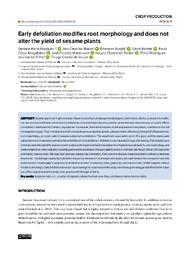Embrapa Pecuária Sudeste
 Busca de Publicações
Busca de Publicações
Early defoliation modifies root morphology and does not alter the yield of sesame plants.
Autoria: MARQUES, D. M.; BLASCO, A. C.; BORGHI, E.; KARAM, D.; MAGALHAES, P. C.; MANTOVANI, J. R.; PENHA, N. C. da; SANTOS FILHO, P. R. dos; SOUZA, T. C. de
Resumo: Sesame plants are highly resistant. However, mechanical damage from hail, pest, and disease attacks, or machinery traffic, can cause a loss in leaf area, characterizing defoliation. In intensified production systems, where leaf area reduction may occur, the effects of defoliation are known for different crop species. For sesame, there are no studies on the response of these plants to defoliation in initial development stages. Thus, the objective of this research was to analyze the growth, photosynthetic efficiency (chlorophyll a fluorescence), root morphology, and grain yield of sesame subjected to defoliation. The experiment was carried out in 20-L pots, and the plants were subjected to two treatments: control (without defoliation) and defoliation. Defoliation was imposed 22 days after sowing. Plant height, stem diameter, and chlorophyll fluorescence were evaluated throughout the plant development. At physiological maturity, root morphology, and yield components were evaluated. Sesame plants under defoliation showed rapid recovery in diameter and height (34 and 50 days after defoliation, respectively). Although leaf area was reduced by defoliation, there were no changes in photosynthetic efficiency between treatments. The damage caused by defoliation caused an increase in root length and surface area and favored the increase in very thin and thin roots. Sesame plants subjected to defoliation resulted in shoot dry mass, grain yield, and harvest index similar to plants without mechanical damage. Early defoliation does not cause damage to sesame under the study conditions, generating possibilities for the future use of this crop in intensified production systems with this type of stress.
Ano de publicação: 2025
Tipo de publicação: Artigo de periódico
Unidade: Embrapa Pecuária Sudeste
Palavras-chave: Desfolha, Estresse mecânico, Gergelim, Harvest index, Mechanical stress, Raiz, Rendimento, Sesamum Indicum, Têmpera fotoquímica

